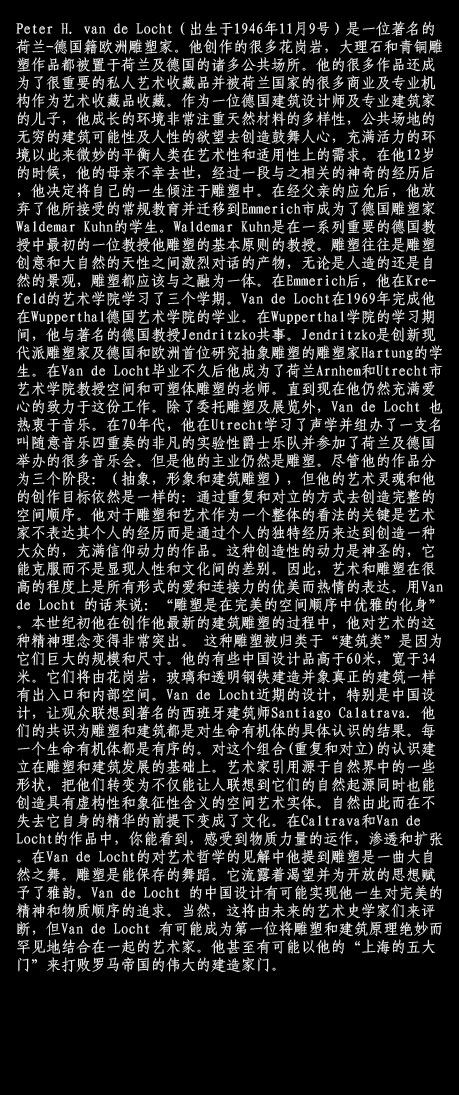Introduction to life and works of sculptor
Peter H. van de Locht.
Written by Willem Jardin (Dutch writer and art philosopher)
Peter H. van de Locht (born november 9, 1946) is a prominent European Dutch-German sculptor who created a substantial number of granite, marble and bronze sculptures that have a permanent place in Dutch and German public space. Many of his works became a part of important private art collections as well as the art collection of Dutch national companies in trade and industry. As the son of a German architect and a master builder Peter H. Van de Locht grew up in an environment that was very much aware of the richess of natural materials, the immense architectural possibilities of public space and men’s desire to create inspiring energetic surroundings in which, in a subtle way, aesthetic and practical dimensions of human needs are balanced. At the age of 12, after a mystical experience that was related to the tragic death of the young boys mother, he decided for himself to dedicate his life to sculpture. His father allowed him to stop conventional education he was involved in and sent him to the city of Emmerich where he started to work as pupil of the German sculptor Waldemar Kuhn. Waldemar Kuhn was the first in a row of important German professors that taught him the basic principles of sculpture. Central to these basic principles was the idea that sculpture always is the result of an intense spiritual dialogue between the idea of sculpture and the natural qualities of the landscape, whether urban or natural, the sculpture is thought to be joined with.
After Emmerich Van de Locht studied three semesters at the Art Academy of Krefeld. He finished his studies in 1969 at the German Art Academy of Wupperthal. On this Academy of Wupperthal he worked with famous German professor Jendritzo, who was a pupil of the revolutionary modernist sculptor Hartung, the man who was the first in Germany and one of the first in Europe to work with abstract forms. Soon after his studies Van de Locht became teacher in Spatial and Plastic Design at the Dutch Art Academies of Arnhem and Utrecht, a job which he, until recently, exercised with much love for his students and their future professions.
Apart from commissions and exhibitions on sculpture Van de Locht also dedicated himself to music. In the seventies he studied Sonology in Utrecht and started a legendary experimental jazz band called the Free Music Quartet that participated in a lot of concerts both in the Netherlands and Germany. But his main work and dedication remained sculpture. And although his works can be divided in three phases (the abstract, the figurative and the architectural sculpture) the spiritual bases of his art and his creative striving remained the same: to accomplish complete spatial order by means of repetition and polarity. Crucial in his vision on sculpture and on art as a whole is the idea that the artist doesn’t express his individual experience, but reaches, with the help of his specific individual experience, to something that is universal and richly filled with energy. This energy is divine and overcomes the differences between humans and cultures in stead of articulating them. This means that art and sculpture are to a high extent graceful and compassioned expressions of universal loving and connecting energy. To use the words of Van de Locht: ‘sculpture is the incarnation of grace within a perfect spatial order.’
Van de Locht’s spiritual approach to art becomes ultimately clear in the development of his latest architectural sculpture since the beginning of this century. This sculpture is typified as ‘architectural’ because of its ambitious scale and dimensions. Some of his Chinese designs for example are more than 60 meters high and have width of 130 meters. They are thought to be constructed of granite, glass and transparent steel and have entrances and inner spaces like real buildings.
Van de Locht’s latest designs, especially the Chinese, makes the spectator think of the works of the famous Spanish architect Santiago Calatrava. Both share the opinion that sculpture as well as architecture is the result of specific knowledge of how living organs are organized. Each living organ is organized and the knowledge of this organisation (repetition and polarity) lies at the root of the development of sculpture and architecture. The artist takes up forms that are derived from nature and transformes them into spatial aesthetic entities that remind us of their own natural origin but at the same time develop meaning that has a mythological and symbolist content. Nature becomes culture without denying its own essences. In both Calatrava’s and Van de Locht’s work you can see and experience material forces at work, penetrating as well as expanding forces.
Sculpture, Van de Locht claims in one of his philosophical notes on art, is a dance of nature. Sculpture is preserved dance. It breeds longing and gives grace to the open mind. Van de Locht’s Chinese designs promise to be a fulfilment of a life’s long search for perfect spiritual and material order. Of course future art historians have to decide, but Van de Locht might well be the first artist to combine in a genious and unprecedented way the principles of sculpture and architecture. With his Five Ports of Shanghai he might even beat the great builders of the Roman Empire.
April 2007, Amsterdam, The Netherlands
